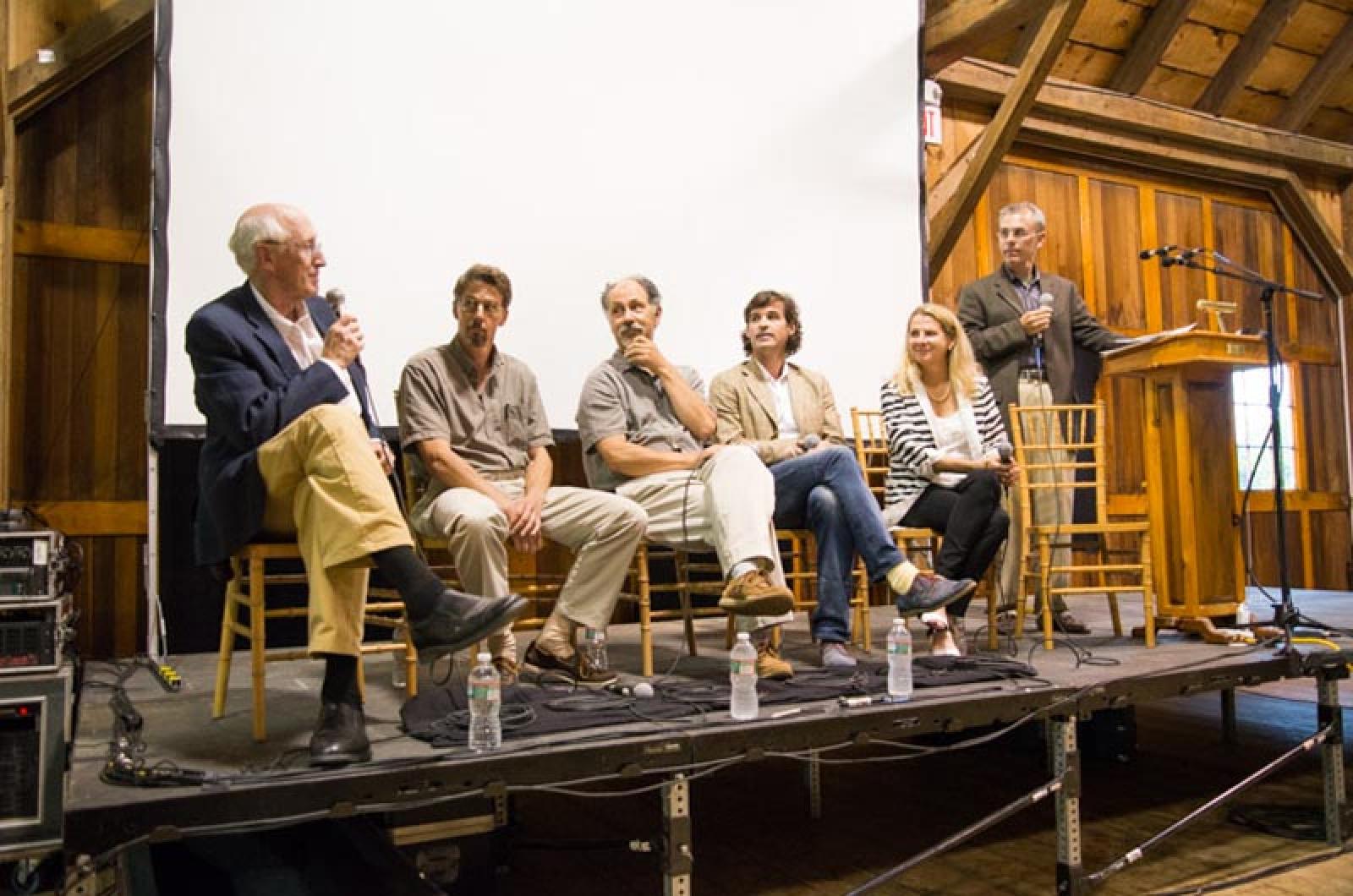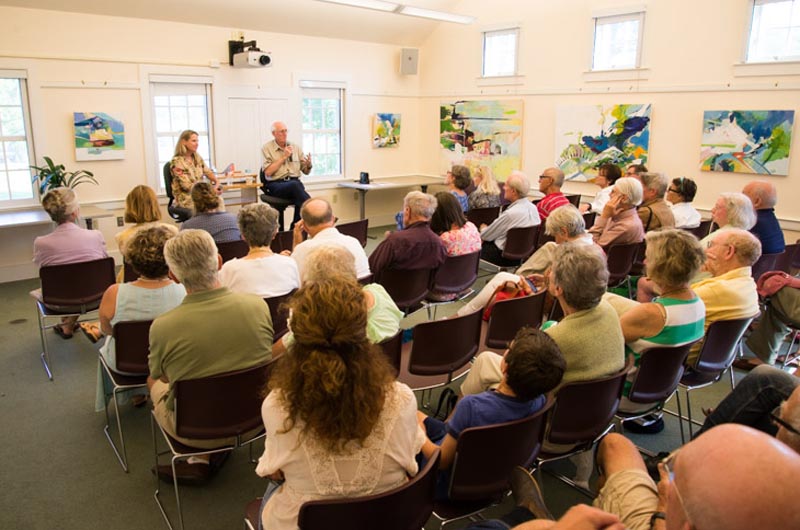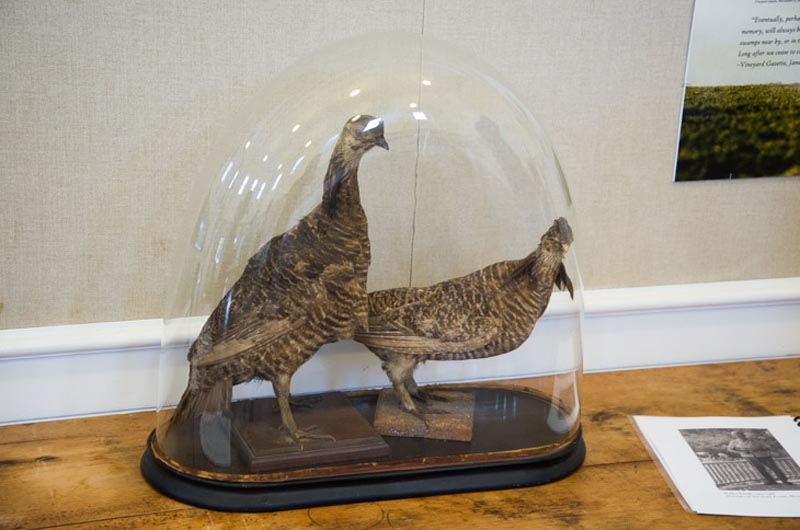Bringing back an extinct species raises a whirlwind of questions — technical, ethical and financial. Would it be possible? Should it be done?
On Thursday evening these topics were addressed before a crowd of more than 150 people at the Agricultural Hall in West Tisbury. The Heath Hen Could Come Back forum featured a panel of six speakers, including the co-founders of nonprofit organization Revive & Restore and representatives from The Nature Conservancy. It was the latest stop in an ongoing conversation with the Vineyard community regarding the feasibility of de-extinction.
A small bird related to and similar in size to a prairie chicken, the heath hen once thrived on the East Coast and was a popular game bird. By the middle of the 19th century, however, its population was limited only to the birds that lived on Martha’s Vineyard. When the Vineyard population began to decline, conservation efforts, including the establishment of a heath hen preserve (now the Manuel F. Correllus State Forest), began. The efforts were among the first of their kind anywhere in the world. But ultimately, the heath hen population continued to decline, falling into an “extinction vortex” as the genetic pool diminished. The last bird died around 1932.
Attendees Thursday night were met with an extensive exhibit on the bird’s history, prepared through a joint effort of the Martha’s Vineyard Museum and the Vineyard Gazette. People stopped to pore over posters describing each stage of the extinction process, to read oral histories of Vineyarders’ memories of the bird, to watch a short video clip of heath hens roaming through shrubbery; and, finally, to take in the sight of two heath hen specimens. These birds are long dead, stuffed into naturalistic poses. They are now part of the museum’s collection.
The Vineyard’s conservation efforts “became a national story and then a global story,” Revive & Restore co-founder Stewart Brand said in his opening remarks. “Martha’s Vineyard gets famous for different things at different times, and it was famous way back when for the heath hen.”
Mr. Brand, who is also the founder of the Whole Earth Catalog, and Ryan Phelan founded Revive & Restore with the goal of using genetic technology to save species that are currently endangered, as well as to bring back extinct species. Animals such as cheetahs and black-footed ferrets are candidate species for the former proposal, based on their low numbers and genetic variability. The heath hen is a candidate species for the latter project.
The event also featured Island ecologists Tom Chase and Matt Pelikan, and Josh Donlan, an ecologist who specializes in island conservation. The panel was moderated by Gazette writer Tom Dunlop. Mr. Chase and Mr. Pelikan both work for The Nature Conservancy, although they stressed that they were not speaking on behalf of the organization, which has not taken a stance on the topic of de-extinction.
“I think the interesting thing . . . about resurrecting a subspecies is it brings the past forward into the future in a tangible way,” Mr. Pelikan said. “Recreating the bird not just as a lab experiment or a genetic project but as a living . . . reproducing thing out on the landscape.”
Mr. Chase spoke to the matter of large-scale habitat restoration and the need for the diverse conservation groups on-Island to work together.
“Can the heath hen be that thing that inspired a unified vision between the conservation groups?” he asked. He didn’t know the answer, he said, but on the Vineyard, “what seems to be a daunting challenge oftentimes becomes commonplace activity.”
Initiating a dialogue with the Vineyard has been a priority for Mr. Brand and Ms. Phelan since they first began investigating the possibility of bringing back the heath hen. The pair also spoke at a well-attended talk held Wednesday evening at the Chilmark library. That event presented a broad overview of de-extinction before honing in on the Island in particular.
“This is really a conversation that we’re starting, and we’re thinking of ways that our organization . . . could help Martha’s Vineyard if they wanted to take on an initiative like this,” Ms. Phelan said on Wednesday.
Mr. Brand offered the example of a plant species, the American chestnut tree. The chestnut was nearly wiped out in the early 20th century because of a fungus blight, and was crossbred with Chinese chestnuts to better resist the disease. Recently, researchers at the State University of New York College of Environmental Science and Forestry discovered a fungus-resistant gene in wheat plants, and moved it into the germ cells of American chestnuts, creating a blight-resistant tree.
“We now basically have a de-extincted plant thanks to this biotech work,” Mr. Brand said. “These beautiful trees, we [can] welcome them back to the Eastern woodlands.”
The process of de-extincting a heath hen involves taking genetic material from museum specimens and manipulating germ cells of a closely related species, in this case the prairie chicken. The prairie chicken was almost used as a source of salvation for the heath hen before, much as the Chinese chestnut saved the American one, but the state of Massachusetts denied a permit to bring the new birds to the Island.
“Everything around de-extinction has to do with how far do we meddle with nature,” Ms. Phelan said. “Some think it’s pure and we shouldn’t meddle at all, and others realize that it’s all manicured . . . and we’re making it and we better do a good job. It’s a big continuum and we all fall on a different level of it.”
Revive & Restore has hosted other conversations about the topic, working first with a group of conservation biologists and geneticists before sponsoring a TEDex talk on de-extinction. That event featured 20 speakers, including “a couple of people who think it’s a terrible idea,” Mr. Brand said.
“A public dialogue was unleashed that continues to this day,” Ms. Phelan said.
A mix of curiosity and healthy skepticism dominated the audience questions on Wednesday, with most concerns centered around logistics. The heath hen, a nesting ground bird, would doubtless fall victim to the many predators here: skunks, raccoons, feral cats.
“So you have to think of the balance in the scale,” said Joanne Polner of New Jersey. “If you’re going to add something you better look to see what’s in its place.”
“It would require an ecological assessment of where the natural balance is,” Ms. Phelan said. An ecological road map might help delineate which species might need to be “dialed down” in order to create an environment suitable for a heath hen.
Mr. Brand said that doing so would benefit other species as well. Reducing predator populations would help the nesting bird population — quail, bobwhite and whippoorwill — that are here, Mr. Brand said. He described the heath hen as an “umbrella species.”
“My point is, how do you want to think about the conservation on your Island to get from where it is to some point where you want it to be?” he asked. “Maybe use some species from the past to enrich the future. I think that’s all that’s being talked about here.”
Conservation efforts in general tend to work better on islands, Mr. Brand said, because they are controlled populations and environments.
Other questions centered around the feasibility of setting aside land where heath hens could live, given that the state forest is no longer a sandplain, and the Island’s parcels of land preserves are managed by many different groups.
Howard Pitsch of Chilmark asked about the overall process of genetic technology, since birds cannot be cloned as mammals can.
The cost of the project, Ms. Phelan said, would be roughly $3 million to $5 million over the span over several years.
“The price of sequencing and all these technologies is just dropping rapidly,” she said.
But the real work, she continued, is in determining interest.
“It’s a question of priorities,” she said.
“Just taking on a de-extinction project is a form of long-term thinking,” Mr. Brand said. “And we may find out it doesn’t work, by the way. This is all science, which means you don’t know what’s going to happen next.”










Comments
Comment policy »